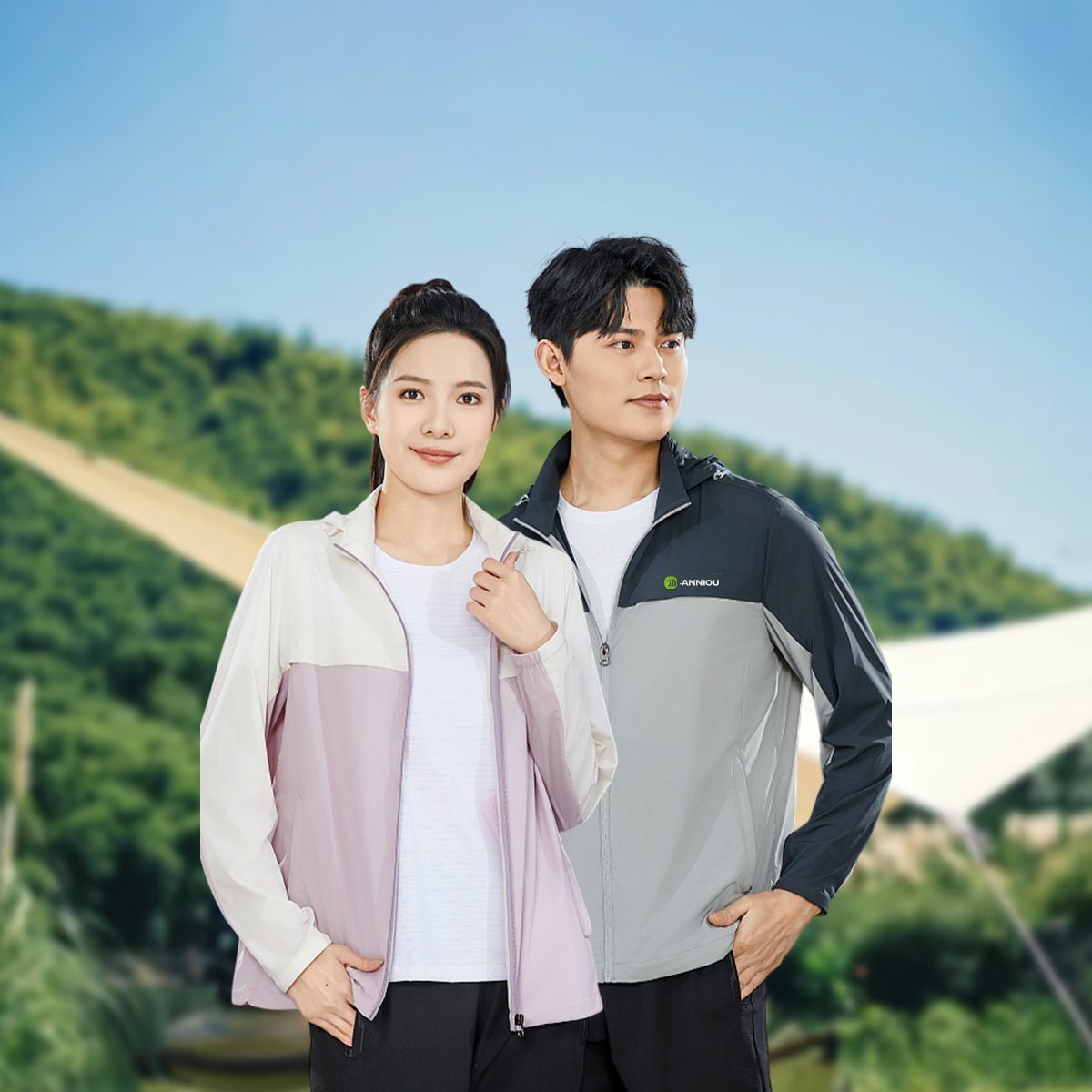Can Clothing Slow Skin Aging? Your Style Guide to UV Protection

Did you know the clothes you wear could be your first line of defense against aging skin? While most of us focus on expensive lotions and treatments, there's a simple yet powerful anti-aging strategy hiding in plain sight: your wardrobe.
Skin aging happens through two main processes. Aging occurs naturally as we get older, driven by genetics and the passage of time. But aging caused by external factors like sun exposure, pollution, and lifestyle choices, accounts for up to 80% of visible skin aging. The good news is that this type of aging is preventable.
UV radiation stands as the primary culprit behind premature skin aging. UVA rays penetrate deep into the skin, breaking down collagen and elastin fibers that keep skin firm and smooth. UVB rays cause sunburn and surface damage that accumulates over time. Both contribute to wrinkles, age spots, and loss of skin elasticity.
Our guide explores how sun protective clothing can slow skin aging while keeping you stylish and comfortable. You'll discover which fabrics offer the best protection, learn about UPF ratings, and find practical tips for building an anti-aging wardrobe that works with your lifestyle.
What Causes Skin Aging?
Understanding the science behind skin aging helps explain why clothing plays such a crucial role in prevention. Intrinsic aging follows our genetic blueprint—collagen production naturally decreases about 1% per year after age 20, leading to thinner, less elastic skin.
Extrinsic aging accelerates this process dramatically. UV radiation breaks down collagen and elastin fibers while triggering the production of harmful free radicals. UVA rays (315-400 nanometers) make up 95% of UV radiation reaching Earth's surface and penetrate glass windows and light clothing. These rays cause deep structural damage that appears as wrinkles and sagging skin.
UVB rays (280-315 nanometers) have higher energy and cause immediate damage like sunburn. They primarily affect the skin's surface but contribute to long-term changes including age spots and skin texture issues. Both types of radiation damage DNA in skin cells, leading to mutations that accelerate aging.
The cumulative effect of UV exposure means that damage builds up over decades, often becoming visible in our 30s and 40s even from childhood sun exposure. This makes consistent protection throughout life essential for maintaining youthful-looking skin.
How Does Clothing Protect the Skin?
Clothing acts as a physical barrier between your skin and harmful UV rays. Unlike sunscreen, which absorbs or reflects UV radiation through chemical or physical filters, fabric protection depends on the material's ability to block and absorb these rays before they reach your skin.
Sun-protective clothing differs significantly from regular garments in both design and function. Standard clothing offers some UV protection, but specialized UV protection apparel undergoes testing to ensure consistent, reliable shielding. These garments often incorporate tightly woven fabrics, darker colors, and sometimes chemical treatments that enhance UV-blocking capabilities.
The Ultraviolet Protection Factor (UPF) rating system measures how much UV radiation can penetrate fabric. UPF 50+ clothing blocks at least 98% of UV rays, making it the gold standard for sun protection. To put this in perspective, a white cotton t-shirt typically provides UPF 5-10, blocking only 83-90% of UV radiation.
Quality sun-protective clothing maintains its protective properties through multiple washes and extended wear, unlike some sunscreens that break down or wear off throughout the day. This consistency makes UPF clothing a reliable foundation for any anti-aging skincare routine.
The Best Fabrics for Anti-Aging Fashion
Fabric choice dramatically impacts UV protection levels. Tightly woven materials create fewer gaps for UV rays to penetrate, making them superior to loose weaves. Denim, canvas, and synthetic fabrics like polyester typically offer excellent protection due to their dense construction.
Polyester deserves special recognition for UV protection. This synthetic material naturally absorbs UV radiation and maintains its protective properties even when wet. Many athletic and outdoor clothing brands favor polyester blends for their durability and consistent UPF ratings.
Colour plays a surprising role in UV protection. Darker colours absorb more UV radiation than lighter shades, preventing it from reaching your skin. A navy blue shirt provides significantly more protection than an identical white shirt. However, modern textile treatments can enhance light-colored fabrics to achieve high UPF ratings without sacrificing style preferences.
Specialised sun-protective fabrics incorporate advanced technologies like ceramic particles, zinc oxide, or titanium dioxide woven directly into fibers. These treatments can turn any fabric into effective UV-blocking apparel while maintaining breathability and comfort.

For building an anti-aging wardrobe, consider these versatile staples:
- Lightweight long-sleeve shirts in breathable fabrics
- Cardigans or lightweight jackets for layering
- Arm sleeves for activities requiring hand mobility
- Pants or leggings that cover legs completely
- Swimwear and cover-ups for water activities
The Importance of Coverage
Maximizing skin coverage provides the most effective protection against UV-induced aging. Areas commonly missed by sunscreen application—like the back of the neck, ears, and spaces between fingers—benefit tremendously from clothing coverage.

Wide-brimmed hats protect the face, neck, and ears while adding sophisticated style to any outfit. Look for hats with at least a 4-inch brim and UPF-rated materials for optimal protection. Baseball caps, while popular, leave the neck and ears exposed to damaging rays.
Full-length trousers and long sleeves might seem impractical in hot weather, but modern moisture-wicking fabrics make coverage comfortable even in high temperatures. Many sun-protective garments actually feel cooler than exposed skin in direct sunlight because they prevent the heating effect of UV radiation on skin.
Beach and pool settings require special consideration since water and sand reflect additional UV radiation toward your skin. Cover-ups, kaftans, and swim shirts provide essential protection during these high-exposure activities. Choose quick-drying fabrics that maintain their UPF rating when wet.
Balancing coverage with comfort becomes easier when you invest in high-quality, breathable fabrics designed for sun protection. These materials wick moisture, allow air circulation, and prevent the trapped heat that makes heavy clothing uncomfortable in warm weather.
Additional Protective Measures
While sun-protective clothing forms an excellent foundation for anti-aging skincare, it works best as part of a comprehensive protection strategy. Clothing alone cannot protect every inch of exposed skin, making supplementary measures essential.
Daily sunscreen application remains crucial for areas that clothing cannot practically cover, such as faces, hands, and feet. Choose broad-spectrum sunscreens with at least SPF 30, and reapply every two hours or after swimming and sweating.
Sunglasses protect the delicate skin around your eyes, where some of the first signs of aging appear. This thin skin lacks oil glands and shows damage quickly through crow's feet and under-eye wrinkles. Look for sunglasses that block 100% of UVA and UVB rays.
Seeking shade during peak sunlight hours (10 AM to 4 PM) reduces overall UV exposure significantly. When shade isn't available, creating your own with umbrellas or pop-up shelters provides additional protection for outdoor activities.
Consider your environment when planning protection strategies. High altitudes, snow, water, and sand all increase UV exposure through reflection and reduced atmospheric filtering. These conditions require enhanced protection through clothing, sunscreen, and behavioral modifications.
Building Your Anti-Aging Wardrobe
Creating an effective anti-aging wardrobe doesn't require a complete style overhaul. Strategic additions of key pieces can dramatically increase your daily UV protection while maintaining your personal aesthetic.
Start with versatile basics that work across multiple settings. A UPF 50+ sweater provides protection for office air conditioning while doubling as sun protection for outdoor lunch meetings. Lightweight, long-sleeve shirts in neutral colors coordinate with existing pieces while offering superior coverage.
Invest in quality over quantity when building your sun-protective wardrobe. Well-made UPF clothing maintains its protective properties longer and often features better construction, comfort, and style details. Many premium brands now offer sun-protective versions of classic styles, from blazers to maxi dresses.
Consider your lifestyle when selecting protective clothing. Frequent travelers benefit from wrinkle-resistant fabrics that maintain UPF ratings. Athletes need moisture-wicking properties alongside UV protection. Parents require durable materials that withstand frequent washing while maintaining protective qualities.
Don't forget accessories in your anti-aging strategy. Scarves, gloves, and wraps can provide temporary coverage for special situations or add protection to shorter-sleeved garments. These pieces also offer flexibility to adjust coverage based on weather, activity, and sun intensity.
Your Path to Age-Defying Style
Clothing represents one of the most practical and effective strategies for slowing skin aging. Unlike topical treatments that require daily application and reapplication, sun-protective clothing provides consistent, reliable protection that becomes second nature once incorporated into your routine.
The dual benefits of UV protection apparel make it an smart investment for anyone serious about maintaining youthful-looking skin. You'll not only prevent future damage but also enjoy the confidence that comes from knowing you're actively protecting your skin every day.
Ready to start building your anti-aging wardrobe? Begin with one or two key pieces like a UPF 50+ long-sleeve shirt or wide-brimmed hat. Gradually expand your collection as you discover which styles work best for your lifestyle. Remember to complement your clothing choices with daily sunscreen application and quality sunglasses for comprehensive protection.
Your future self will thank you for every day you choose protection over exposure. Start today, and make anti-aging fashion a cornerstone of your skincare routine.



0 comments